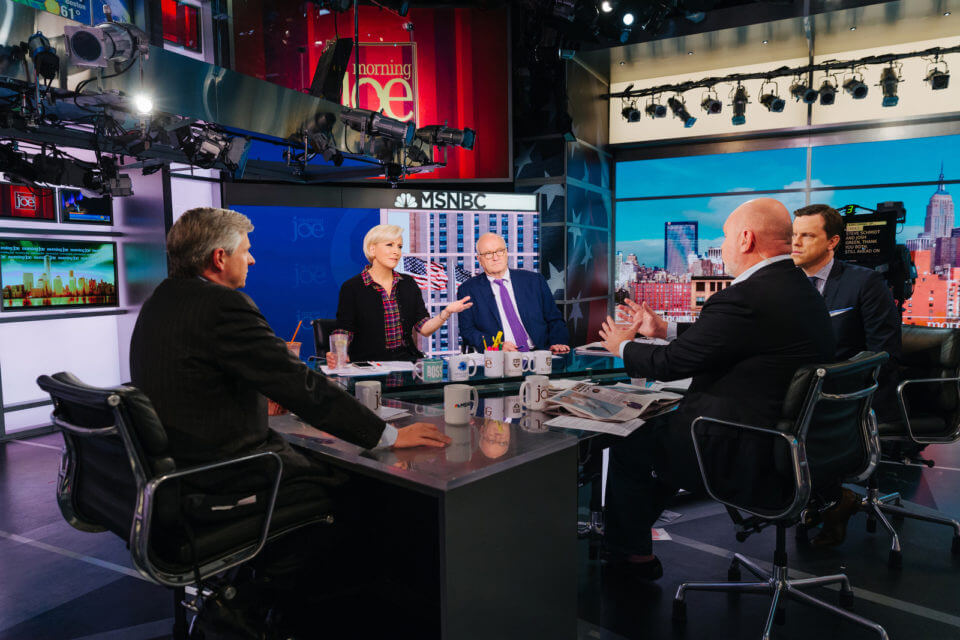
“Importing these ideas into your sense of self—to think of yourself as a liberal or a conservative—is irrational and corrosive. It is a recipe for error.”
Thinking of political action along a conservative-liberal axis is nothing new. Institutions and individuals have been lumped along these lines for centuries. 250 years ago, the architects of American democracy were, by the lights of their times, liberal theorists. Across the pond, contemporaneous statesmen and philosophers like Edmund Burke were champions of conservatism. Just about every permutation of participatory governance has been carved along some version of that centuries-old partisan axis.
As abstractions, these terms have relatively clear meanings. Conservatism celebrates tradition and institutionalized moral systems. It greets change and difference with glowering circumspection. Liberalism places its core emphasis on individual liberty and recognizes change as both an inevitable outworking of personal freedom and a likely route to progress.
But cast back onto the shifting, idiosyncratic world of day-to-day human life, these concepts lose a lot of explanatory traction. Instead of clarifying ideas and relationships, they tend to obscure nuance and individual variation. Burke, for instance, was a fairly archetypal conservative—a stuffy religious moralist, through and through. He also happened to support America’s largely secular and distinctly liberal revolution. John Stuart Mill, meanwhile, was a champion of personal liberty. This is liberalism in the classical sense. Yet perplexing, the modern political stage—at least in the United States—casts liberals as stewards of government excess and the ensuing restraints on the scope of individual action that excess entails.
Despite its messiness, the conservative-liberal binary has cemented itself in the popular consciousness. In the United States, the majority of regular, active voters have latched onto one or the other pole and bricked it into their individual identity. The political stage, then, is an either-or contest between Democrats and Republicans. Functionally speaking, the two parties have managed to make themselves the sole avatars of liberalism and conservatism, however loosely and inconsistently defined.
As a result, the political sphere has been rendered all but unnavigable. On either side of the political spectrum, discourse is dominated by unhinged ideologues whose voices are amplified by their reactionary opposites and an attention-hungry media that feasts on controversy. The most salient opinions are often those most thoroughly divorced from discernible reality. From pole to pole, nuance and clarity are actively derided. On the political right, a pandemic has become a hub for belligerence and conspiracy theories. On the political left, race, gender, and power have suddenly transformed into religious fetishes, and dissent has become an act of intolerable violence. The political arena is no longer a contest of ideas, but of identities.
None of this reflects a political reality anyone would esteem. And most of us—regardless of how we voted in the last election—recognize this. But because the idea of left and right, of liberal and conservative, has seeped so deeply into our brains and characterizes so much of our political discourse, many of us are left fumbling for fresh traction. There is something kooky—even dangerous—going on in the shrill fringes. It is true wherever you look. Unfortunately, our way of understanding ourselves as political animals does not leave us with a lot of options. Open dissent from political orthodoxy risks excommunication—from friends, from family, from professional affiliations.
Here we find one of the chief risks of political identitarianism. We preferentially build relationships with people similar to ourselves, and that picture of similarity is as deeply rooted in self-conception as it is in blind artifacts of personality and disposition. By conceiving of ourselves as liberals or Democrats, for example, we substantially curtail our ability to exchange ideas and build relationships with people who conceive of themselves as anything else. As a corollary, the conceptual space we can openly and freely navigate is sharply constrained. Groups coalesce around dispensed wisdom. Questioning tribal precepts turns into an untenably charged business. The idea of liberal or conservative allegiance has sunk such firm anchors in our minds—and those of our peers—that a contrarian position has come to carry vast personal costs, both real and perceived.
The Utility of Political Taxonomy
There has always been something vaguely noxious about a person incorporating notions like left and right, liberal and conservative, Democratic or Republican into her personal identity. In the most extreme case—Democrat vs. Republican—these terms only make sense as matters of professional affiliation. Some people are literally Democrats or Republicans, in that they work in some capacity for one of these two private organizations (whose chief concern, it is always worth reiterating, has never been anything beyond crass and callous self-perpetuation).
More commonly, these versions of political taxonomy are best deployed in reference to some variety of measurable ephemera: voting behavior in an election or one-time donations to a specific candidacy. These are situations in which the crude exigencies of history force most Americans to choose between one of two options, neither of which reasonably expresses or represents their actual political preferences.
Plenty of people who recognize anthropogenic climate change as a global threat are fiercely resistant to nuclear power, one of the best available options for curbing our habit of spewing hydrocarbons into the atmosphere.
More broadly—and more usefully—the liberal-conservative paradigm serves as a coarse taxonomy for behavior and preference. Mapping and understanding political behavior is enormously challenging. Political scientists are faced with the rough and daunting work of trying to boil down a vastly complicated and idiosyncratic field—the preferences and choices of tens of millions of people—into something statistically tractable and easier to digest. Paving over the messy bits and ignoring the fact that few people fit cleanly into any particular conceptual bin is really the only way to do this.
The vast majority of people are not that ideological—few of us spend enough time thinking about politics to develop a consistent set of preferences. Relatedly—and perhaps more importantly—we are also riddled with biases and contradictions. The same person who thinks abortion ought to be off the table regardless of circumstances will happily support the death penalty for minors and write off the occasional execution of the falsely accused as the cost of doing business. Plenty of people who recognize anthropogenic climate change as a global threat are fiercely resistant to nuclear power, one of the best available options for curbing our habit of spewing hydrocarbons into the atmosphere.
True, there are patterns in individual human preference. For instance, psychological research has revealed interesting correlations between sensitivity to disgust and political affiliation (i.e., conservatives tend to be more easily disgusted than liberals). Some individuals prize tradition and consistency. This gives them a conservative bent. Others are more open to change and embrace novelty. That lends itself to a liberal outlook. These patterns are amplified in aggregate. But, on the ground, they do not actually characterize who any of us actually are.
Point being, by any clean and consistent metric, no living human is actually completely liberal or conservative. These are constructs. Researchers use them to make sense of a wide and shifting realm of human behavior. In that regard, they are enormously valuable. But exported to the humdrum world of workaday human interaction, they lend themselves to a dangerous reification fallacy, driving us to sort ourselves along boundaries with scant relevance to the basic mechanics of daily living. As a cog in the cognitive machinery that grinds out political behavior, they lead us to adopt allegiances and stake out positions we would likely eschew under some other framework. Instead of a piecemeal engagement with the issues that matter most to us as individuals, we reflexively accept and regurgitate party-line doctrines on matters we really do not understand. Where we ought to plead ignorance or indifference, we evangelize. Where we ought to embrace debate and compromise, we build unbridgeable barriers.
Increasingly, these dynamics have come to shape the entire political landscape. Analyzing decades of data and dozens of elections, political scientists Christopher Achen and Larry Bartels show that American electoral behavior has become reflexively—even religiously—partisan. We do not vote for the candidate with the best ideas or against the candidate with the worst performance. Instead, we reliably punch the ticket next to the name with which we most closely identify. All variation—that is, all swings in preference—is fed by voters who do not harbor deep partisan identities and react chiefly to a subjective accounting of how well things have gone for them in the sixth months leading to an election (a phenomenon Achen and Bartels call myopic retrospection).
This phenomenon cuts to the bone. People actually modulate their expressed preferences and opinions to better correspond with partisan identity. As abortion became increasingly politicized in the 1970’s and 1980’s, women—that is, those most affected by any legal framework bearing on the issue—hopped to whatever party best matched their extant view. Men, on the other hand, simply adopted the prevailing line handed down from whatever party they were already affiliated with. Conservative champions of choice suddenly became ardent and punitive “pro-lifers.” Liberal men who thought human zygotes were inalienably precious decided they were dispensable.
Modern Political Identity: An Exercise in Incoherence
In every election since 2004 (the first year I was old enough to vote), I have ticked the boxes for Democratic candidates. If I take a political affiliation quiz (all of which, it is worth remembering, are to some degree flawed), I would wind up ranked as some flavor of liberal. For example, if I take the Political Compass assessment—something I was introduced to well over a decade ago in a political science 101 course—I wind up in a quadrant staked out for the libertarian left. This means I generally think people ought to be able to do what they want (take drugs, watch pornography, have whatever form of consensual sex that matches their fancy, etc.), but I also believe government regulation is essential to solve the coordination problems involved in ecological conservation and workers’ rights. I have taken this assessment a handful of times over the years and shifted around that lower left quadrant. But, by and large, this result has been consistent.

Importantly, many of my specific political positions have changed over time. This is unsurprising. In a few cases, I have learned more about how the world works. In many others, I have learned enough to know that I really do not know anything. As a result, it has become increasingly clear that most issues are far less clear cut than they look at first blush, and that partisan instincts—whether rooted in innate psychology, education, or crude indoctrination—are a recipe for erroneous thinking.
Still, broadly speaking, I fit pretty neatly in the box political scientists use to capture liberal behavior. I believe in equality of opportunity and largely unfettered free speech. I think consenting adults should be able to build whatever kinds of sexual (or asexual) relationships they want. Marijuana should be legal; all drugs should be at least decriminalized; and the “war on drugs” should end. Substantial prison reform is an ethical imperative. The death penalty is cruel and pointless. I cherish public lands. Decades of systemic, race-based oppression have hurt generations of people, and we should work to remedy the resulting imbalances. I believe science is one of humanity’s most important and valuable cultural enterprises, and it should be funded generously.
In other words, if you asked a random person to draw a liberal from memory, it would probably look a little like me. There is nothing wrong with this. Everyone steps onto the political stage with a preexisting set of preferences and inclinations. These, summed and balanced, afford us a spot somewhere on the political spectrum. For most, that spot is not dead center. By some mix of genes and upbringing, we find certain ideas and policies more satisfying than others. It makes sense for researchers to develop a taxonomy for capturing this variation.
Importing these ideas into your sense of self—to think of yourself as a liberal or a conservative—is irrational and corrosive. It is a recipe for error. There are places where liberal orthodoxy, dispensed in the United States along party lines, is misleading, if not flatly wrong. Rent controls, for instance, contribute to housing shortages. Nuclear power is an extremely safe alternative to fossil fuels. Although they have other ill effects, neoliberal economic policies have, on the whole, reduced poverty and improved standards of living across the globe. Modern capitalist democracies tend to be more stable and less violent than alternative systems. By almost every metric, the vast majority of people are better off today than they were 30, 40, 50, or 60 years ago (or any other time interval you might care to specify). More generally, the Democratic reflex to seek out a government solution for every problem is inefficient and unsustainable.
Too firm an identification with an abstract summary of disposition and preference makes these conclusions unreachable. Where not specifically taboo, they frequently stand unaddressed—shunted aside in favor of more readily appealing issues. Navigating the world of ideas as a self-identified liberal or conservative is like swimming with a chunk of stone hung around your neck. You will feel compelled to stay in the shallows where it is safe and powerfully disinclined to explore fresh territory.
Strident brands of doctrinaire partisanship would see anyone willing to seriously engage with the tangled complexities of social and physical reality banished. Today, one must pronounce falsehoods and denounce imaginary sins to maintain an unvarnished record in the liberal collective. As propounded by the loudest—if not necessarily most influential—voices on the Left, one must accept some variation of the following: All sex differences are learned artifacts of culture. Genes play no part in shaping human behavior. Racism and sexism are as bad or worse than they have ever been. Science, reason, and logic are tools of white supremacism. Intent does not matter. All action and expression should be judged according to its worst possible interpretation. Words are violence.
Equally extreme flavors of radicalism poison the political right. These range from the ideological fanaticism of anarcho-capitalist libertarian philosophies to outright (and real) white supremacy. On a more pedestrian level, they are evident in the broad support still enjoyed by President Donald Trump—a morally and intellectually bankrupt huckster. His presidency would be impossible in a world where people were not so deeply entrenched in political tribalism. This leaves us to wonder: How did we get here? How have we found ourselves stuck between two worlds of partisan madness?
Negative Partisanship
For decades, political discourse—and, more importantly, political action—has been more a matter of what we hate than what we like. Appropriately enough, this adversarial approach to the political game is called negative partisanship.
Under the right circumstances, versions of negative partisanship are entirely rational. Sometimes the best we can do is make the least bad choice. Other times, it is more important to avert a crisis than shepherd a utopia. Liberals exhaust a lot of my political attention worrying about what Republicans have been up to. The converse is true for many conservatives.
Piecemeal, this is not inherently bad. One can conjure examples of liberal or conservative policy that, given the right set of eyes, look disastrous. Fearing oligarchy’s ceaseless erosion of representative governance, one might vote against a Republican presidential candidate who will empower originalist Supreme Court justices, regardless of what the opponent looks like. Worried over growing tax and regulatory burdens, a small business owner might vote against a Democratic Senate candidate who will likely support heavier taxation and more onerous regulation, even if the Republican alternative is otherwise unappealing. This is all perfectly sensible.
Most Americans are flogged into political action by concerns about what the other side will mess up when they grab the reins. This is the terminal phase of an electorate that has fully internalized a partisan binary and incorporated it into their conceptions of self.
Things turn ugly when large swaths of the electorate find themselves voting against conservative policies as liberals (or vice versa). Sadly, this has become the norm. Most Americans are flogged into political action by concerns about what the other side will mess up when they grab the reins. This is the terminal phase of an electorate that has fully internalized a partisan binary and incorporated it into their conceptions of self.
Large proportions of the electorate have been fully assimilated into identitarian madness that neither party wastes much time cultivating a positive vision. Instead, they simply busy themselves making sure their constituents are properly whipped up with visions of what the other side will do. This makes it very easy for the loudest, most extreme voices on either side to thoroughly monopolize our attention. Thereafter, the craziest acolytes of far-left or far-right ideology become the most quickly retrievable archetypes for a far more complicated and diverse theater of political action. We have come to view regular people, who mostly are not concerned with things outside of the daily business of paying bills and maintaining personal relationships, as caricatures fashioned from the worst ideas of people who vote like them in national elections. This is extremely fertile ground ideological extremism.
In the world of partisan identity, politics is an “if you are not with us, you are against us” affair. This is clearly a bipartisan issue. Conservatives who express concern over President Trump or the sycophancy and extremism of the GOP writ-large are frequently labeled “cucks” or “RINOs” (Republicans in Name Only) by the party faithful. The same dynamic unfolds on the left. Thinkers such Steven Pinker, Sam Harris, Jonathan Haidt, and Bari Weiss—who are, at worst, centrists—are frequently classified by the public arbiters of liberal propriety as right-wing maniacs or racists. Sometimes, this happens merely as a result of their espousing a view fully consistent with research and evidence. Consider, for instance, this piece of startling inanity, in which the writer argues reason and civility are dangerous standards for political discourse because some proponents of slavery once misdeployed them in service of their vile cause.
The bounds of partisan rectitude have become so narrowly defined that a nuanced opinion or contrarian impulse has become a source of serious cognitive dissonance. Thinking of ourselves as members of a certain political tribe, in turn, we reflexively censor ourselves for perceived political wrongthink. Openly questioning orthodoxy—let alone staking out a firm stance against it—is grounds for ostracism and repudiation.
This is precisely the dynamic Achen and Bartels revealed. It is increasingly in vogue for liberals to cast racism and sexism as the source of all modern ailments. Conservatives, meanwhile, traffic ever more heavily in white Christian victimhood narratives. All of this is nonsense. Racism and sexism exist. Some people probably do not like white people or Christians. But as the most extreme versions of these views—that some version of ethnicity-or-gender-based power dynamics taint all human interaction, or that white male Christians are part of some widely demonized and persecuted class—come to dominate party lines, and people with strong political identities greet them with de facto acceptance.
News Media Fuels the Madness
The most extreme voices poisoning the water are a minority. Unfortunately, the structure of the modern media ecosystem makes this easy to forget. In fact, on close enough inspection, it becomes clear that the news media is a chief cause of our modern political derangement.
Editorial decisions at most news platforms are not fueled by carefully considering what the public ought to know in order to live more informed and enlightened lives. They are crafted by a delicate, mercenary, and ultimately risk-averse calculus: what can we do to attract as many new eyeballs as possible without losing the ones we already have. Essentially, media outlets like MSNBC and Fox News farm us for attention, which they then convert into advertising revenue. Having long ago realized that fear and outrage are far more lucrative than nuanced reflection and discourse over complicated issues, they have developed a business model based on seeking out the slightest embers of controversy and dousing them with gasoline.
In this way, everything from conservative talk radio to Vox Media has traipsed into the discovery that partisan rancor and hysteria are highly profitable.
This, of course, is slippery territory. It is easy to move from the simple recognition that market incentives drive bad reporting and fuel partisanship to the world of hand-wringing conspirators and sneering puppet-masters. But nothing like that need be the case. The cold taskmaster of profit maximization has simply driven media outlets to blindly search a design space—human psychology—and move in whatever direction smells the most like money. Brainless bacteria do basically the same thing in following nutrient gradients, following an algorithm that says, “when there are two energy units to the left and one the right, move left.” In this way, everything from conservative talk radio to Vox Media has traipsed into the discovery that partisan rancor and hysteria are highly profitable. Thereafter, coverage dedicated to harvesting these returns has sown and fertilized the seeds of growing political identitarianism and strife.
The New York Times, for instance, pays gilded lip service to all manner of lofty ideals, but their ultimate master is the bottom line. Call it crass if you like, but it is just as much a matter of survival. Whenever and wherever possible, the paper will highlight and amplify controversy. In doing precisely that, The New York Times’ chief executive, Mark Thompson, has for years worked to leverage the crazed mechanics of social media to further the paper’s reach and expand its subscriber base. Doing this, The New York Times has become increasingly reliant on trafficking in the coarse pornography of victimhood in lieu of anything resembling careful reporting. It is a course set by the ideological biases inherent in the paper’s approach to staffing, plucking new recruits from a rarified stock of uber-privileged elites. Generally speaking, these are people who have encountered very little actual adversity in life and are (coincidentally, perhaps) the people most committed to a lunatic fringe, where words are violence and all human interaction should be dissected down to the slimmest possible fibers of racial and gender animus.
Contrary to any right-wing account, this is not a deliberate ideological crusade. Mark Thompson did not set about some crusade to spread the holy doctrines of postmodern hokum and critical studies onanism. Rather, he just wanted to make his employer more economically viable. He tried a strategy of hiring young elites who had been carefully trained to seek out controversy and follow the faintest scent of racial strife like febrile truffle pigs. Shockingly, it worked. They were able to plug into the same myopic psychological architecture that powers the most profitable companies on the planet (e.g. Facebook) and show Thompson a return on his investment. And that process—blindly stumbling toward profit—is how, to paraphrase Bari Weiss, Twitter became the editorial voice of The New York Times.
It is worth reiterating here that this is not a singularly liberal phenomenon. Right-wing media actually pioneered the strategy. For decades, conservative talk radio and Fox News have used bloviating, red-faced commentators to attract attention and sell advertising space for erectile dysfunction pills and gold stocks. Information media is putatively geared toward the higher end of tuning us all into what is really happening in the world. Regardless of partisan bias, most outlets have instead tracked death-or-growth cash gradients wherever they lead. As a byproduct, they have helped turn huge segments of the electorate into gibbering ideologues.
Unsurprisingly, platforms like Facebook and Twitter worsen these problems. Increasingly desperate for a shrinking slice of fleeting attention, news outlets exaggerate their extant predilections for discord and hyperbole. Algorithms steer users toward whatever inflammatory content will most reliably seize their focus and get them to stop scrolling for a couple of seconds, which most news outlets supply by the bucketload. Meanwhile, the formerly isolated denizens of the fringe—conspiracy theorists and science deniers, political extremists, and ideological fanatics—find one another and build fresh, hermetically sealed communities around their favorite brand of nonsense. And since social media is built around the careful cultivation and curation of perception, these platforms turn personal identity into an active obsession. As a result, we have seen formerly marginalized ideas—fodder for bitter misanthropes and confused undergraduates—blossom into full-blown movements.
A vicious feedback cycle ensues. The discourse on social media becomes more extreme. News outlets—ever hungry for conflict and apparently unable to tell the difference between the most strident social media influencers and measurable reality—shift to more extreme positions. We now live in a world where political discourse is dominated by the most extreme voices on one side yelling past the most extreme voices on the other, pausing only to tell anyone who happens to raise a timid point of dissent in the middle—often something tedious and inconvenient about facts, logic, and data—to shut up and sit down.
A Route Out of the Wilderness
Political action has become fully and finally performative—more an advertisement of personal commitment and in-group affiliation than an expression of considered preference. Liberals march through the streets tearing down statues of abolitionists and their clear and workable policy solutions. Conservatives dress up in GI Joe cosplay to fight the savage tyranny of having to wear a 14-gram piece of fabric over their faces at Home Depot. All of this does little more than signal devotion to identity beyond reason.
Americans have come to identify more and more strongly with their political preferences, even as their ability to actually shape policy and express preferences has effectively evaporated. Ideologically activated youths tear down monuments to dead men, while oligarchs and their political cronies seize ever more political power. Frightened by visions of those politically impotent youths—and their proximity to and endorsement by Democratic politicians—conservatives vote for representatives who actively and openly champion policies that erode middle and lower class political power. No cabal of sinister puppet masters has done this. Spurred by tribal affiliation and encouraged by media sensationalism, Americans are so busy decrying the statistically insignificant absurdities of the other side that we ignore things that actually matter. It is divide-and-conquer as an emergent phenomenon.
Deeply set partisan identities encourage recalcitrance and bolster zero-sum ideological fanaticism. And there we see the rise of fiercely intransigent ignoramuses: the Squad on the Left and the Tea Party on the Right. Speak with actual humans, and it swiftly becomes apparent that few people actually embrace these crackpot orthodoxies. Yet across the political spectrum, people feel simultaneously constrained and tarred by these extremes.
This is an insane predicament. It is also untenable. Sooner or later, something is going to break. Our best hope is that the rupture point is conceptual. Those of us in the exhausted middle wash our hands of the whole thing and let the gibbering fringes spin off into deep space. Let them bark into the void, while the rest of us get back to the hard, frustrating, incremental work of building and running better and better versions of society. By shucking off the old baggage of partisan identity and ceasing to root our senses of self in a framework with no use beyond the world of scholarly inquiry, we can actually begin to build coalitions around formerly invisible points of consensus while confronting—sensibly, calmly, openly—the points of disagreement that really matter.
This is key. No political party is going to embrace a full and final disavowal of partisan identity, nor are media platforms that feed off controversy like vampire bats on sleeping calves likely to encourage it. This change must be entirely grassroots. Individual Americans have to reject the idea that political affiliation is a core component of who they are as people. It is not easy work. Not by any stretch. Excising the liberal or conservative brand from your brain is a matter of constant, deliberate effort, rendered harder still by the fact that the political landscape is not ready to accommodate this kind of heterodoxy. After all, when ones goes to the polls in the United States, one is still effectively faced with a choice between an avatar of the Left and an avatar of the Right.
Breaking that structure down will likely take decades. But it is never going to happen if the majority of Americans remain blindly invested in identities that dictate policy far in advance of reason and evidence. Fortunately, there are functional political steps we can take to erode this blunt, corrosive, and antiquated order. Instituting rank-choice/instant-runoff voting would chip away at rancorous, recalcitrant partisanship, while giving more power to third party alternatives. Turning over electoral maps to nonpartisan redistricting commissions would undermine the prospects of extremist candidates. These proposals face their own obstacles, of course, but that is hardly the point. They show us that there are, in principle, routes out of the wilderness—almost certainly more than we are currently equipped to envision.
According to the loudest voices in the room, I am not a liberal anymore. I am too enamored of things like reason and science for them. Nor, detesting President Trump as I do and generally suspicious of unfettered capitalism and religious dogma as I am, can I hop off the S.S. Liberal and swim over to the S.S. Conservative. But I can close my eyes and—concentrating hard—remember that those ships are just constructs. They do not reflect the full nature of the ocean, and I do not need either to stay afloat. I can be something more complicated and unwieldy than either can contain. From there, the real work of imagining something better can begin.
Zane Beal is a writer and researcher whose work can also be found at Quillette, Areo, and highplainsskeptic.com.










